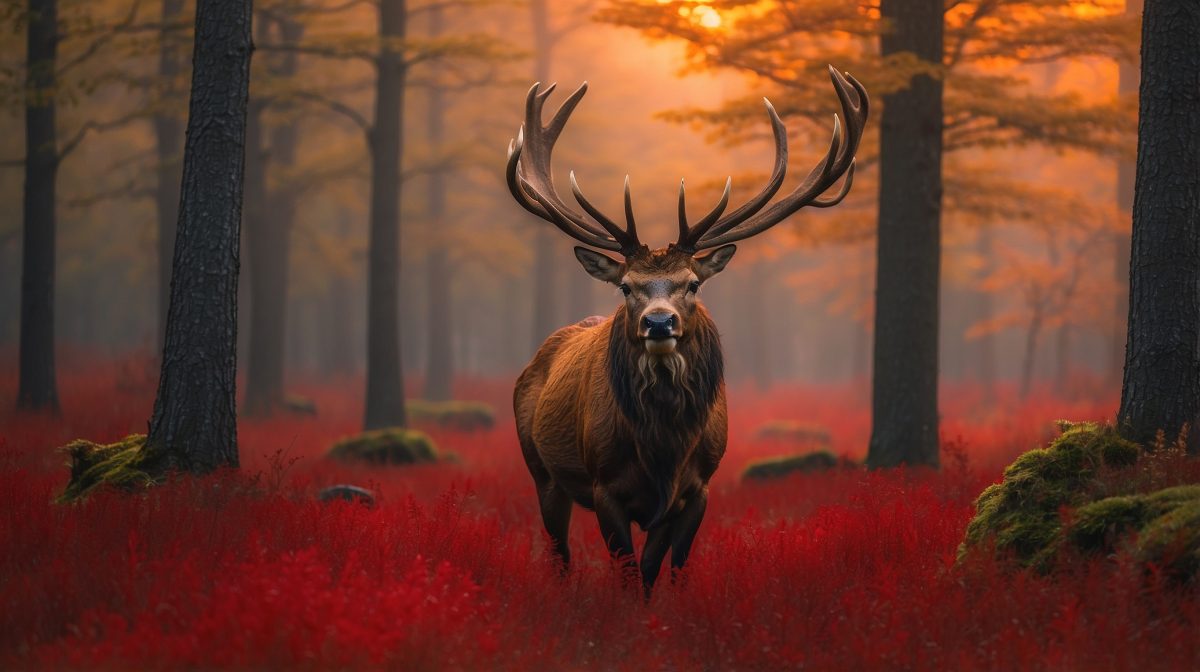Red Stag Behavior
Mating Season Dynamics
When the Texas air gets crisp and the leaves start showin’ their autumn colors, red stags enter the rut, an annual mating ritual that’s as rowdy as a honky-tonk on a Saturday night. For hunters, this is prime time, as stags are less cautious and more focused on showin’ off for the ladies. Understanding the intricacies of the rut, including the behaviors and areas stags frequent, can make or break your hunt.
Now, if you’ve ever been out in the brush and heard a sound that’s part bugle, part roar, you’ve heard the call of a red stag. These vocalizations are a key to their behavior during the rut. They use them to attract females and challenge rivals. For a savvy hunter, recognizing these calls can lead you right to the action, provided you respect the animal and the chase.
Daily Patterns
Red stags, much like us Texans, have their daily routines. Come dawn and dusk, you’ll find them grazin’ in the fields and meadows, fuelin’ up on native grasses and plants. This is the best time for hunters to set up, as stags are most active during these hours. Knowin’ their feeding habits and preferred grazing spots gives you a leg up in plannin’ your hunt.
But every critter needs its rest, and red stags are no different. They tend to bed down in thick cover during the midday heat, especially in the scrub and brush that’s plentiful around these parts. Understandin’ their downtime is crucial for plannin’ your approach, as you don’t want to be stompin’ around and spookin’ them when they’re tryin’ to catch some shut-eye.
Red Stag Habitat
The Texas Hill Country Ecosystem
The Texas Hill Country is a veritable smorgasbord for a red stag, with a diverse spread of plant life that keeps ’em healthy and robust. From live oaks to junipers and the sumptuous grasses in between, this ecosystem provides the perfect pantry for these creatures. Hunters need to familiarize themselves with these vegetation types, as they’re likely spots to find a grazing stag.
Water is the lifeblood of the Hill Country, and the rivers and streams crisscrossin’ the landscape are just as vital for the red stag’s survival. These majestic animals need to drink regularly, so water sources become hotspots for activity. As a hunter, keepin’ a keen eye on these areas can lead to successful encounters with these stags.
Shelter and Territory
When it comes to restin’ and roamin’, red stags have their preferences. They’re fond of the woodlands and clearings that dot the Hill Country, usin’ the dense cover for bedding and the open spaces for feedin’. Recognizin’ these patterns in their habitat is like readin’ a good book – it tells you where the stags are likely to be at any given time.
Now, red stags are territorial, especially during the rut. They’ll defend their patch of land with a vigor that’s admirable. As hunters, it’s important to recognize and respect these territories, both for our safety and to maintain the natural order of things. Disturbin’ a stag in its own territory can be a dangerous game, so tread lightly and with respect.
Seasonal Impact on Red Stag Behavior and Habitat
Spring and Summer
Spring in the Hill Country is a time of renewal, and for red stags, it means the start of antler growth. This process can influence their behavior, as they’re more sensitive and protective of their new growth. Hunters need to be mindful of this, as it can affect how stags react to their presence. Summer brings abundance in food, which in turn influences the movement and health of the stags. This season is a time for growth and preparation for the challenges of the rut.
As the days get longer and the mercury rises, you’ll see these stags takin’ advantage of the lush vegetation. The food sources are plentiful, and the stags will be movin’ around to the best grazing spots. This seasonal change in their diet and movement patterns is something hunters should note when plannin’ their strategies.
Fall and Winter
When the air gets a nip and the days grow short, the rut kicks into high gear. Behavior changes significantly during this peak season, with stags becomin’ more aggressive and less wary. For hunters, it’s an opportunity to witness the full spectacle of red stag behavior, but it also requires careful planning and ethical consideration to ensure a respectful hunt.
With winter’s chill, weather patterns begin to heavily influence red stag movement. The cold can push stags to lower elevations or into more sheltered areas. Hunters need to be prepared for these conditions, both in terms of gear and tactics. Understandin’ how the weather affects stags can be the difference between a successful hunt and a long, cold walk back to the ranch.
Ethical Hunting Practices
Population Management
Here in the Hill Country, we take our role as stewards of the land seriously, and that includes population management. Hunters play a critical part in maintainin’ a healthy balance in the ecosystem. By followin’ quotas and regulations, we ensure that red stag populations remain robust and the natural order is preserved for generations to come.
Fair chase principles are at the heart of ethical hunting. It’s about givin’ the animal a fair shot, quite literally. This means no baitin’, no cornerin’, and no takin’ shots that ain’t clean. It’s the respect we show for the hunt and the creature that makes the experience honorable and true to the spirit of the Texas outdoors.
Habitat Conservation
Protectin’ the habitat of the red stag is just as important as any other aspect of huntin’. Without the land, there ain’t no animals, and without the animals, well, there ain’t no huntin’. It’s our duty to conserve the natural beauty and resources of the Texas Hill Country, not just for the red stags, but for all the wildlife that calls it home.
Conclusion
Ain’t no doubt about it, red stags are among the most fascinating creatures you can find in the Texas Hill Country. Understanding their behavior and habitat is not just about increasing your chances of a successful hunt; it’s about respecting these animals and the beautiful land they call home. Now that you’re armed with this knowledge, may your hunting experiences be as rich and rewarding as a Hill Country sunrise.
FAQs
What’s the best time of day to hunt red stag?
The best times are dawn and dusk when they’re most active and grazin’.
How can you tell if a red stag is nearby?
Look for signs like tracks, droppings, or listen for their distinct calls.
What are some common mistakes hunters make during the rut?
Underestimatin’ the stags’ focus on mating and overestimatin’ their caution.
How do weather patterns affect red stag movement?
Cold weather can drive stags to lower elevations or sheltered areas.
Is there a red stag hunting season in Texas Hill Country, and if so, when is it?
Yes, there’s a season. It typically runs from October through January, but always check local regulations for the most accurate information.


